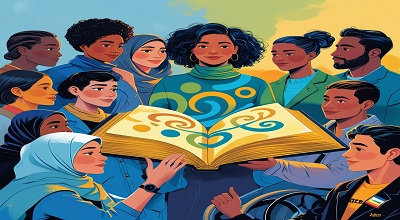Cultural Inclusivity Resources
Cultural inclusivity in education is a critical aspect of fostering diverse learning environments that support all students, regardless of their cultural, racial, or linguistic backgrounds. As the world becomes more interconnected, schools must adapt to meet the needs of a diverse student body. This article explores various cultural inclusivity resources available for educators in 2025, with examples of best practices, tools, and strategies.
1: What is Cultural Inclusivity?
- Definition: Cultural inclusivity refers to the practice of recognizing, respecting, and valuing diverse cultural backgrounds in the classroom.
- Importance in 2025: As global migration increases and digital learning transcends geographical boundaries, inclusivity is not just a moral imperative but a pedagogical necessity.
2. Key Challenges in Achieving Cultural Inclusivity
- Addressing biases and stereotypes.
- Managing language barriers.
- Incorporating multicultural perspectives into curriculum design.
The Evolving Landscape of Education and Cultural Inclusivity
In 2025, the landscape of education has dramatically shifted. The integration of technology, increased access to global educational resources, and a heightened emphasis on diversity have contributed to the evolution of cultural inclusivity.
Technological Advancements in Education
- Virtual learning environments that enable global classrooms.
- AI-powered tools that assist in translating content and tailoring it to individual cultural needs.
- Interactive platforms like VR and AR that bring diverse cultures to life in immersive ways.
Globalization and Cultural Diversity
- The rise of multicultural classrooms in both K-12 and higher education.
- A greater focus on preparing students for a globalized economy that requires cultural competency.
Key Cultural Inclusivity Resources for Educators in 2025
Educators now have access to a wealth of tools and resources that support cultural inclusivity. From textbooks to online platforms and professional development programs, here’s a look at some of the top resources.
Curriculum Design Tools
- Multicultural Textbook Publishers: Companies that specialize in textbooks that reflect diverse cultures, histories, and perspectives.
- Open Educational Resources (OER): Free, openly licensed educational materials that allow educators to customize content to better fit diverse classrooms.
- Inclusive Digital Platforms: Platforms like Google Classroom, Microsoft Education, and Edmodo that support diverse learning needs.
Professional Development Programs
- Culturally Responsive Teaching (CRT) Workshops: Teacher training that focuses on strategies for effectively teaching students from diverse cultural backgrounds.
- Anti-bias Training Programs: Programs designed to help educators recognize and address their own biases.
- Cultural Competency Certification: Online courses and certifications that help educators build cultural awareness and sensitivity.
Inclusive Classroom Technologies
- Speech-to-Text and Translation Tools: Tools like Google Translate and Microsoft Translator to bridge language gaps in multicultural classrooms.
- Assistive Technologies: Devices and apps that support students with disabilities while promoting inclusivity.
Diverse Classroom Materials and Literature
- Books and Literature: Culturally diverse books for all age groups, promoting multicultural literacy.
- Representation in Visual Materials: Including diverse artists, photographers, and other creators in classroom materials to ensure diverse representation.
Strategies for Implementing Cultural Inclusivity in the Classroom
Effective strategies go beyond simply using inclusive resources. Teachers must actively integrate them into their teaching methods to create a truly inclusive environment.
Inclusive Teaching Practices
- Differentiated Instruction: Adapting teaching methods to meet the diverse needs of students from different cultural backgrounds.
- Culturally Responsive Pedagogy: Connecting students’ cultural backgrounds to the learning material to increase engagement and understanding.
- Collaborative Learning: Encouraging group work that allows students from different cultural backgrounds to share their perspectives.
Curriculum and Content Integration
- Multicultural Literature Circles: Using literature from various cultures to create a rich, diverse reading experience for students.
- History and Social Studies: Incorporating global perspectives into history lessons to ensure a more inclusive view of world events.
- STEM and Cultural Relevance: Teaching science, technology, engineering, and mathematics (STEM) concepts through the lens of diverse cultures and historical figures.
Classroom Environment
- Culturally Responsive Classrooms: Designing physical and virtual learning spaces that reflect students’ cultural diversity.
- Celebrating Cultural Holidays and Traditions: Incorporating cultural celebrations and practices to create an inclusive environment.

Examples of Schools and Educators Excelling in Cultural Inclusivity
1: Case Study 1: A Global Learning Environment in New York City
- How a public school in NYC integrated global learning tools and culturally responsive teaching practices to build inclusivity.
2: Case Study 2: The Power of Multicultural Literature in San Francisco
- A San Francisco-based elementary school’s success in using culturally diverse books to enhance literacy and foster inclusivity.
3: Case Study 3: Virtual Classrooms and Cultural Exchange Programs
- A case study of a virtual classroom initiative that connects students from different countries, allowing them to learn from each other’s cultural perspectives.
The Role of Parents and Communities in Supporting Cultural Inclusivity
While educators play a vital role in promoting cultural inclusivity, parents and communities must also be involved. By supporting the work of educators, they help create an environment where all students can thrive.
Parental Involvement
- Encouraging parents to share their cultural practices and traditions with the class.
- Establishing community groups that promote multicultural understanding.
Collaborating with Community Organizations
- Partnering with cultural organizations to bring real-world cultural experiences into the classroom.
- Hosting community events and workshops that promote inclusivity.
The Future of Cultural Inclusivity in Education
As we look to the future, the importance of cultural inclusivity in education will only grow. In 2025 and beyond, the education system must continue to evolve to accommodate the changing demographic of students and foster a truly inclusive learning environment.
Adapting to Technological Changes
- The use of AI to provide personalized, culturally relevant learning experiences.
- Innovations in virtual reality (VR) and augmented reality (AR) to expose students to different cultures and traditions.
Focus on Global Citizenship
- Teaching students to think globally while respecting and appreciating local cultural identities.
- Preparing students for careers that require intercultural communication skills.
FAQs
1: What is cultural inclusivity in the classroom?
Cultural inclusivity is about ensuring all students feel valued and represented, regardless of their cultural or ethnic background.
2: Why is cultural inclusivity important in education?
It promotes equality, enhances learning experiences, and prepares students for a diverse and interconnected world.
3: What are some examples of cultural inclusivity resources?
Resources include multicultural textbooks, professional development workshops, inclusive digital platforms, and assistive technologies.
4: How can I create a culturally inclusive classroom environment?
You can integrate diverse materials, celebrate various cultural traditions, and use inclusive teaching practices.
5: What are the challenges of promoting cultural inclusivity?
Challenges include addressing biases, overcoming language barriers, and creating a curriculum that represents all cultures.
6: How do parents and communities contribute to cultural inclusivity in schools?
Parents and communities can share their cultural practices, collaborate with schools, and provide resources to enhance cultural understanding.
7: What is the future of cultural inclusivity in education?
The future will see increased use of technology, global learning environments, and a stronger focus on teaching students to be global citizens.
Conclusion
Cultural inclusivity in education is more than just a trend—it is a fundamental shift in how we approach teaching and learning. As we move further into 2025, educators, schools, and communities must continue to evolve, embracing new resources, strategies, and technologies that ensure every student has the opportunity to succeed in a diverse world.
